ASRock ConRoe945G-DVI: Core 2 Duo goes mATX
by Gary Key on September 1, 2006 5:15 AM EST- Posted in
- Motherboards
Features and Layout
ASRock designed a very well laid out board with all major connections easily reached. The layout provides very good clearance for cards and components while being very simple to install in our mid-size ATX case or mATX case. The board features a 4-phase voltage regulator power design that provided very good stability during general usage and light overclocking.
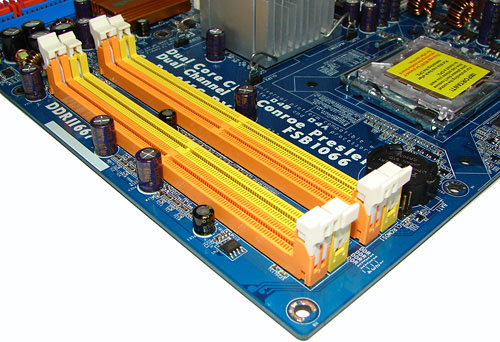
The DIMM module slots' color coordination is correct for dual channel setup. The memory modules are easy to install with a full size video card placed in the PCI Express X16 slot. The battery and clear CMOS jumper are located at the right edge of the number one DIMM slot.
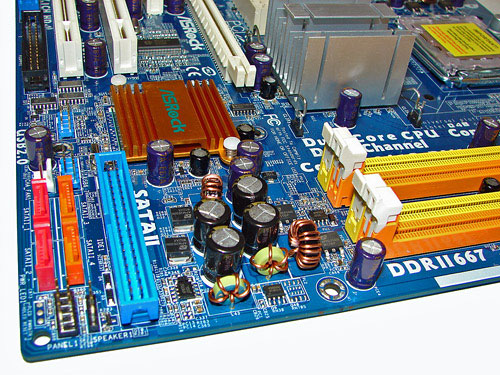
The orange and pink Intel ICH7 SATA ports are conveniently located on the board's left edge and next to the blue IDE port connector. Unlike other recently reviewed boards the SATA ports are color coded for primary and secondary operation if this is important to you. We found the positioning of the SATA ports to be excellent when utilizing the PCI slots or the single IDE port connector. The Intel ICH7 chipset is passively cooled with a low-rise heat sink.
The blue IDE did not present any connection issues in our mid-size ATX case or SFF test case. The location of this connector is very good for most cases and those users still utilizing IDE hard drives. The chassis panel and system fan header are located on the left edge of the board near the SATA ports. The two USB 2.0 headers are located to the left of the Intel ICH7.
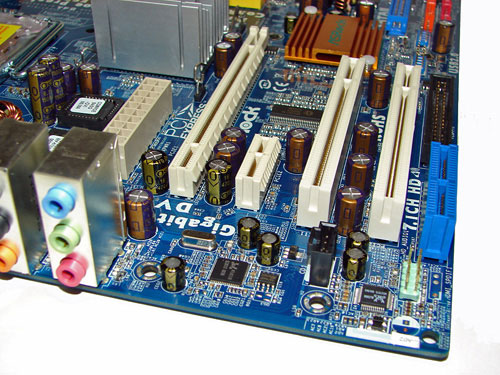
The board comes with one physical PCI Express X16 connector, one PCI Express X1 connector, one HDMR slot, and two PCI 2.3 compliant 32-bit connectors. The layout of this design offers a good balance of expansion slots for a mATX board.
The 20-pin ATX power connector is located in an unusual position in front of the large passive heat sink for the Intel 945G MCH. The PCI Express X16 connector is located next followed by the single X1 PCI Express connector. The location of this PCI Express X1 connector allows installation of most peripheral PCI Express cards and is only blocked by most dual slot video card designs.
The two PCI connectors are located next and followed by the HDMR slot. The black floppy drive connector is located in an inconvenient position behind the HDMR slot. The front audio panel header is located in front of the HDMR slot.
Returning to the CPU socket area, we find an ample amount of room for alternative cooling solutions. We utilized the stock Intel heat sink but also verified our Tuniq 120 Tower and Scythe Infinity would fit in this area during our tests, although we doubt most users of the this board would go to that extreme to cool the processor.
The Intel 945G chipset is passively cooled with a large heat sink that did not interfere with any installed peripherals. Our only concern is the location of the 20-pin ATX power connector as the cabling tends to interfere with the CPU heat sink/fan during usage. ASRock places the four-pin ATX power connector at the top of the CPU socket area and next to the CPU fan header.
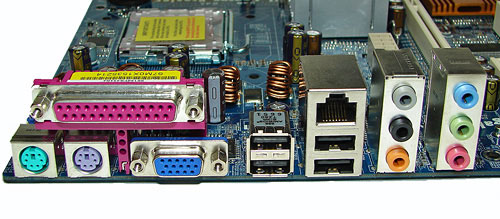
The PS/2 mouse and keyboard ports are located on the bottom of the I/O panel and underneath the LPT parallel port. The VGA port is located to the left of the first two USB ports and below the LPT parallel port. The LAN (RJ-45) port and the second pair of USB 2.0 connectors are located next to the first set of USB ports. The audio panel consists of 6 ports that can be configured for 2, 4, 6, and 8-channel audio connections.
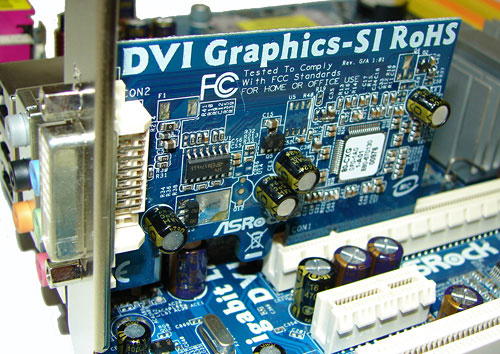
ASRock ships a DVI accessory card that installs into the PCI-Express X16 slot and offers dual monitor capability when utilized with the onboard Intel 950GMA solution. In our testing, this capability worked well with general office applications such as Word or Excel.
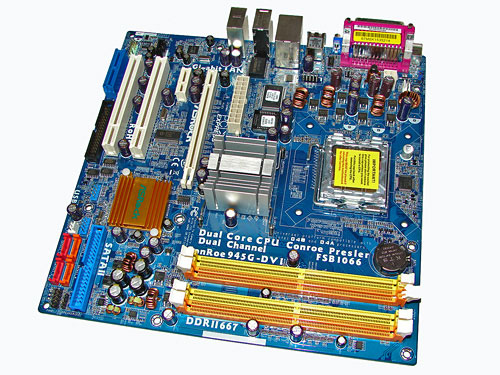 |
| Click to enlarge |
ASRock designed a very well laid out board with all major connections easily reached. The layout provides very good clearance for cards and components while being very simple to install in our mid-size ATX case or mATX case. The board features a 4-phase voltage regulator power design that provided very good stability during general usage and light overclocking.

The DIMM module slots' color coordination is correct for dual channel setup. The memory modules are easy to install with a full size video card placed in the PCI Express X16 slot. The battery and clear CMOS jumper are located at the right edge of the number one DIMM slot.

The orange and pink Intel ICH7 SATA ports are conveniently located on the board's left edge and next to the blue IDE port connector. Unlike other recently reviewed boards the SATA ports are color coded for primary and secondary operation if this is important to you. We found the positioning of the SATA ports to be excellent when utilizing the PCI slots or the single IDE port connector. The Intel ICH7 chipset is passively cooled with a low-rise heat sink.
The blue IDE did not present any connection issues in our mid-size ATX case or SFF test case. The location of this connector is very good for most cases and those users still utilizing IDE hard drives. The chassis panel and system fan header are located on the left edge of the board near the SATA ports. The two USB 2.0 headers are located to the left of the Intel ICH7.

The board comes with one physical PCI Express X16 connector, one PCI Express X1 connector, one HDMR slot, and two PCI 2.3 compliant 32-bit connectors. The layout of this design offers a good balance of expansion slots for a mATX board.
The 20-pin ATX power connector is located in an unusual position in front of the large passive heat sink for the Intel 945G MCH. The PCI Express X16 connector is located next followed by the single X1 PCI Express connector. The location of this PCI Express X1 connector allows installation of most peripheral PCI Express cards and is only blocked by most dual slot video card designs.
The two PCI connectors are located next and followed by the HDMR slot. The black floppy drive connector is located in an inconvenient position behind the HDMR slot. The front audio panel header is located in front of the HDMR slot.
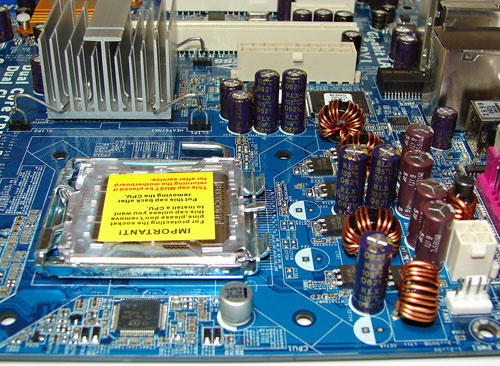 |
| Click to enlarge |
Returning to the CPU socket area, we find an ample amount of room for alternative cooling solutions. We utilized the stock Intel heat sink but also verified our Tuniq 120 Tower and Scythe Infinity would fit in this area during our tests, although we doubt most users of the this board would go to that extreme to cool the processor.
The Intel 945G chipset is passively cooled with a large heat sink that did not interfere with any installed peripherals. Our only concern is the location of the 20-pin ATX power connector as the cabling tends to interfere with the CPU heat sink/fan during usage. ASRock places the four-pin ATX power connector at the top of the CPU socket area and next to the CPU fan header.

The PS/2 mouse and keyboard ports are located on the bottom of the I/O panel and underneath the LPT parallel port. The VGA port is located to the left of the first two USB ports and below the LPT parallel port. The LAN (RJ-45) port and the second pair of USB 2.0 connectors are located next to the first set of USB ports. The audio panel consists of 6 ports that can be configured for 2, 4, 6, and 8-channel audio connections.

ASRock ships a DVI accessory card that installs into the PCI-Express X16 slot and offers dual monitor capability when utilized with the onboard Intel 950GMA solution. In our testing, this capability worked well with general office applications such as Word or Excel.










33 Comments
View All Comments
passport - Wednesday, September 13, 2006 - link
With this board in order to overclock higher than 299 you either have to do the CPU,PCIE Sync which will allow you to go up to about 130-320 before you knacker your SATA drives or you can set it to CPU,PCIE Async; set PCIE to 117 (no effect on system) and then you are able to go up to 350 (runs a 6400 @ 2.8 gHZ). Don't forget that at these speeds you are also overclocking your memory so open up the timings before you try it.RomanMtz - Wednesday, September 13, 2006 - link
Hello... I plan on using this budget board as a transition board until the Lanparty series for Conroe is released or more OCing board options arise. My only concern is that, while I will probably use it stock with a E6600, I want to make sure my Geforce 7950GX2 fits in it. I read the Epox 945 MATX review on Hard and they mentioned that that card did not physically fit in that board. Any comments about this would be greatly appreciated. Thanks!deathwalker - Tuesday, September 5, 2006 - link
Are the overclocking shortcommings of this board (cpu core vlt/memory vlt)correctable thru possible future bios updates?JarredWalton - Tuesday, September 5, 2006 - link
Possibly, but I wouldn't count on ASRock making the changes. Most of their boards have the same BIOS limitations and have for a while now. :|deathwalker - Tuesday, September 5, 2006 - link
I sure home ASUS gets there P5B-VM to the market place soon. I want to get my hand on a good MicroAtx Core 2 Duo board so I can upgrade my Ultra Fly SFF system.roman2 - Tuesday, September 5, 2006 - link
I have bought a pretty similar board recently - Asus P5LD2-VM SE. It is a stripped-down board, but for a real bargain. I also have Core2 E6400 (8x, 2.13GHz, step.B2) and 2x1GB Corsair XMS2 675MHz-CL4.I've been trying to overclock this configuration and was able to reach 297 MHz FSB stable (2.37GHz CPU, 742MHz 4-4-4-12 memory, both stock voltage). The board has quite good CPU/memory voltage setting capabilities, but I wasn't able to post after 299 MHz. Any suggestions?
What is the best memory timing for these Corsair modules at such a high frequency?
What is the maximum safe voltage for CPU and what for the memory? (I didn't try to push the voltage much higher to not destroy the thing).
I have the board for a month now, for a month overclocked and must say it was worth it. But if I could achieve even higher overclock, it would be really nice :-)
PotatoMAN - Sunday, September 3, 2006 - link
Thanks again AT. I always enjoy reading your articles and they usually have most of what I am looking for. Like others before my post, I too want to see power consumption. I am looking for a solution to put in my car as I will be fabricating a carputer in the coming months. Seeing as how I expect the Core Duo to last, and I don't want to upgrade my carputer for years to come, this probably will be the solution pending the power consumption of the mainboard coupled with the CPU. It would be nice to get some comparison along with the Centrino line processors, as well =)kmmatney - Friday, September 1, 2006 - link
Although the DVI riser card is a great idea (and gives the the possibility of dual monitors) it seems like the sensible thing to do would be to have a DVI connector as the standard on-board connector. You can always use a DVI-to-VGA adapter if necessary, and those must be cheaper than the riser card. Anybody with enough cash to go dual-screen can buy another cheap card, or better yet, a card with dual DVI output.agent2099 - Friday, September 1, 2006 - link
I know most of us interested in mATX boards are especially interested if a board includes two particular things:Component video output (for onboard video)
SPDIF audio output
Future roundups should include whether or not a board has these features.
yyrkoon - Friday, September 1, 2006 - link
Well, owning an Asrock motherboard I feel compelled to speak up on the subject. While my motherboard is an Asrock AM2NF4G-SATA2, I have a feeling the feature set (minus the DVI card) is probably pretty much the same. After one months times of owning this board, I would have to say that it is a well thought out board in most respects.However, that being said, there is a few things of concern relating to this board as well.1) As stated in this article, The Asrock AM2NF4G-SATA also has limited memory, and vcore adjustments, which is probably to be expected in a budget motherboard. I was however able to eek out a 16% OC by dropping the multiplier to 11x, and raising the HT to 250MHZ. Raising it any higher caused system instabilities. Dropping the multiplier further resulted in a lower OC, which I felt wasnt worth the time playing around with.
2) Setting up a SATA as the boot disk on these motherboards seems to be borderline un-exceptable. First, you must go into the BIOS, and change the SATA operation mode to [RAID], enter into the RAID BIOS utility, identify, and set the drive as a 'spanning' (JBOD) array, and THEN either have a driver slipstreamed copy of XP, or have a floppy attached. To make matters worse, these steps are not in the manual, and after talking to technical support on the phone (email technical support is shyte, until you get an actual email address from a rep), it took me several hours of trial and error, to figure out the proceedure. Another thing to note, is that these steps must be followed if you expect to run XP setup with a SATA attached period, whether its the boot disk, or not, otherwise you'll have to disconnect the drive, and re-attach it afterwords.
3) Stability seems to be an issue on this system, although, this could be attributed to software, I'm still trying to iron out the details (yes, after a month). Its hard tracing the problem since the system seems to randomly reboot, once every 2-3 days, and its a hard reboot, with no BSoD. I suppose this problem COULD be related to another peice of hardware, I'll have to figure that out.
Anyhow, I would like to know if the problems (except for #1) I've experienced with my motherboard, hold true for this motherboard as well. I would like to add, that for the price, this motherboard is probably well worth it, once you get used to the odd behavior, and realize that this motherboard wont OC very well (should be known to begin with anyhow), it could prove to be a decent motherboard. I'll just have to keep testing the stability issues of my own, and on a clean XP Pro install, so far (in about 18 hours) no random reboots.